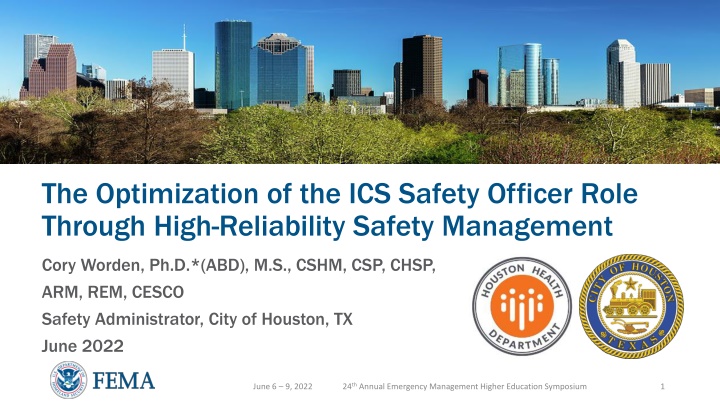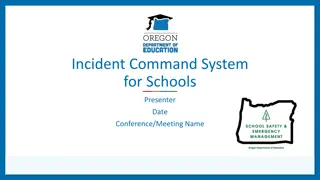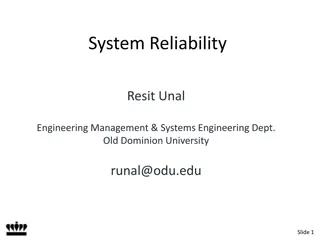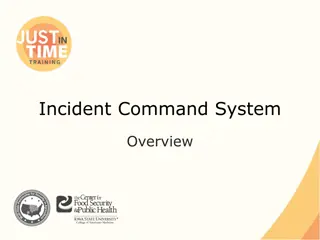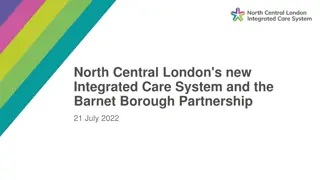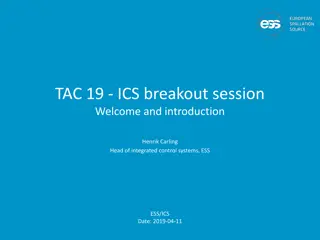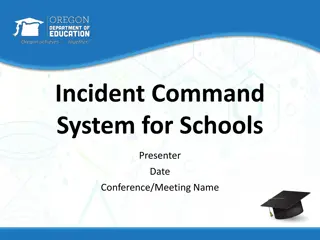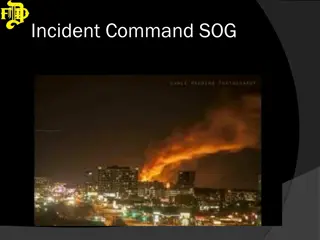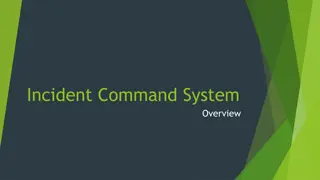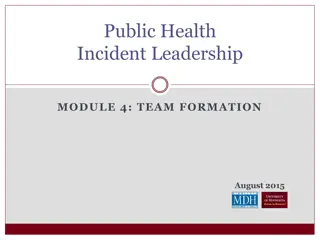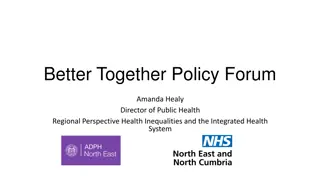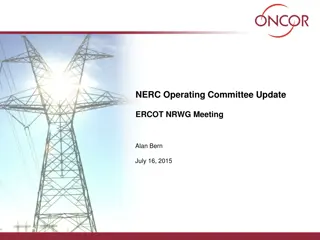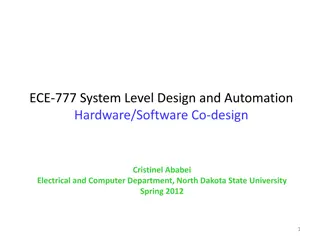Optimization of ICS Safety Officer Role Through High-Reliability Safety Management
Enhance the role of ICS Safety Officers by implementing high-reliability safety management principles. Explore methodologies for developing a COVID-19 response plan, identifying indicators for measuring effectiveness, and prioritizing risk management strategies such as risk avoidance, acceptance, and control. Delve into safety management, continual improvement, and the importance of deference to expertise, sensitivity to operations, and commitment to resilience. Learn about safety messaging, incident analysis, and hazard/threat control within a high-reliability framework.
Download Presentation

Please find below an Image/Link to download the presentation.
The content on the website is provided AS IS for your information and personal use only. It may not be sold, licensed, or shared on other websites without obtaining consent from the author.If you encounter any issues during the download, it is possible that the publisher has removed the file from their server.
You are allowed to download the files provided on this website for personal or commercial use, subject to the condition that they are used lawfully. All files are the property of their respective owners.
The content on the website is provided AS IS for your information and personal use only. It may not be sold, licensed, or shared on other websites without obtaining consent from the author.
E N D
Presentation Transcript
The Optimization of the ICS Safety Officer Role Through High-Reliability Safety Management Cory Worden, Ph.D.*(ABD), M.S., CSHM, CSP, CHSP, ARM, REM, CESCO Safety Administrator, City of Houston, TX June 2022 24th Annual Emergency Management Higher Education Symposium June 6 9, 2022 1
Objectives Identify high-reliability principles. Identify ANSI Z.10 Safety Management System components. Identify methodology to develop COVID-19 response plan by ANSI Z.10 methodology. Identify leading and lagging indicators measuring the effectiveness of the ANSI Z.10 implementation during the City of Houston s COVID-19 response. 24th Annual Emergency Management Higher Education Symposium June 6 9, 2022 2
Emergency Response and Safety Planning. Preparedness. Response. Notification. First response. Extended response. Recovery. 24th Annual Emergency Management Higher Education Symposium June 6 9, 2022 3
Risk Management Risk categories. Strategic risk. Operational risk. External risk. Hazard/threat risk. Risk treatment options. Risk avoidance. Risk acceptance. Risk transfer. Risk control. 24th Annual Emergency Management Higher Education Symposium June 6 9, 2022 4
Safety Management and Continual Improvement ANSI Z.10 24th Annual Emergency Management Higher Education Symposium June 6 9, 2022 5
Safety Management and High-Reliability Deference to Expertise Deference to Expertise Sensitivity to Sensitivity to Operations Operations Preoccupation with Preoccupation with Failure Failure Commitment to Commitment to Resilience Resilience Reluctance to Simplify Reluctance to Simplify Incident Incident Hazard/Threat Hazard/Threat Analysis Analysis and Risk Assessment and Risk Assessment Safety Messaging Safety Messaging Lagging Indicators Lagging Indicators Leading Indicators Leading Indicators Incident Analysis Incident Analysis Hazard/Threat Control Hazard/Threat Control 24th Annual Emergency Management Higher Education Symposium June 6 9, 2022 6
Infrastructure and Subject Matter Expertise National Incident Management System. Incident Command System. Emergency Operations Center. Safety Management. Safety Committee(s). Worker safety. Patient safety. Public safety. Infection prevention and control. Professional associations. 24th Annual Emergency Management Higher Education Symposium June 6 9, 2022 7
Hazard Analysis Hazard identification. Hazard characteristics. Routes of entry. Methods of transmission. Metrics. Has the Safety Plan been completed? Any new hazards/threats (physical, violence, electrical, weather, CBRNE, or other)? Any changes to hazards (new research, etc.)? 24th Annual Emergency Management Higher Education Symposium June 6 9, 2022 8
Types of Hazards/Threats Dynamic versus Stagnant. Conditions/Environment. Equipment/Materials. Work Practices. Patients/Clients/Visitors/Bystanders. Weather. 24th Annual Emergency Management Higher Education Symposium June 6 9, 2022 9
Hazard Analysis Blood or Bodily Fluid Exposures (skin contact) Needlestick/ Sharps Injury (possible BBP exposure) Motor Vehicle Accident Chemical Electrical Ergonomics Strains Classification ADMINISTRATION MANAGER ADMINISTRATIVE AIDE ADMINISTRATIVE ASSISTANT ADMINISTRATIVE COORDINATOR ADMINISTRATIVE SPECIALIST ADMINISTRATIVE SUPERVISOR ASSISTANT CUSTOMER SERVICE MANAGER ASSISTANT DIRECTOR (EXECUTIVE LEVEL) BUREAU CHIEF,PUBLIC HEALTH (EXECUTIVE LEVEL) CASHIER CHEMIST IV CHIEF PHARMACIST 24th Annual Emergency Management Higher Education Symposium June 6 9, 2022 10
Risk Assessment Risk groups. Working with known pathogens or known potential exposures (i.e. clinical, testing, lab). Working with potential exposures and determining risks in real-time (i.e. clinical). Living in society during a pandemic (i.e. shopping, social functions). Variances within risk groups for different functions. Different job expectations. Different exposure potentials. Variances within risk groups for same functions. Different tasks. Different personal variables (health, home life). 24th Annual Emergency Management Higher Education Symposium June 6 9, 2022 11
Risk Assessment Risk Frequency and Severity. Low to high frequency. Asymptomatic to fatal. Vaccination status. Personal risk perceptions. Transparency with organizational risk level/treatment decisions. 24th Annual Emergency Management Higher Education Symposium June 6 9, 2022 12
Hazard/Threat Control Regulations and National Consensus Standards. Layers of protection. Different purpose of each control (source control, hand hygiene, disinfection, protection). Personal opinions and perceptions of what is unsafe. 24th Annual Emergency Management Higher Education Symposium June 6 9, 2022 13
Hazard/Threat Control Hierarchy of Controls. Elimination. Substitution. Engineering. Administration. Source control versus Respiratory Protection. Market flooded with products, some hazardous (disinfectants, sanitizers). Contamination control procedures. Training Personal Protective Equipment (PPE). Supply line variances, price gouging, and counterfeiting. Shortfalls and reuse protocols. Emergency Use Authorizations (EUA). 24th Annual Emergency Management Higher Education Symposium June 6 9, 2022 14
Respiratory Protection 29 CFR 1910.134 versus Appendix D (Voluntary Protection Program). Hazard analysis. Medical evaluations. Training. Fit Testing. NIOSH approval versus Emergency Use Authorizations versus reuse protocol versus disinfection. 24th Annual Emergency Management Higher Education Symposium June 6 9, 2022 15
Situational Awareness and Hazard/Threat Identification 24th Annual Emergency Management Higher Education Symposium June 6 9, 2022 16
Colonel Boyds OODA Loop Applied to Disease Exposure Prevention 24th Annual Emergency Management Higher Education Symposium June 6 9, 2022 17
Hazard Controls What controls are needed for each hazard/threat in the analysis? Regulations. Standards. Policies. Hierarchy of Controls. Training. Metrics. New or necessary controls (i.e. vehicle barriers, security/Law Enforcement presence). Changes or needs for existing controls (i.e. PPE is implemented but a different model is needed). Training/preparedness completion status (i.e. respirator Fit Testing). 24th Annual Emergency Management Higher Education Symposium June 6 9, 2022 18
Hazard Controls Can we put barrier between employee and hazard? Applicable Regulations, Policies and Other Guidance Can hazard be eliminated? Can hazard be substituted? (something less dangerous) Blood and Bodily Fluid Exposures 29 CFR 1910.132 / 1910.1030 x x Equipment 29 CFR 1910.132 / 29 CFR 1910.120 / Texas HAZCOM Act specific regulations as applicable Depends on the chemical and its function Chemical x Equipment / Facilities Electrical 29 CFR 1910.301 / NFPA 70E x x Equipment Ergonomic / Adjustable Equipment Ergonomics General Duty Clause (OSH Act) x Ergonomic / Adjustable Equipment Mechanical 29 CFR 1910.147 x Different Equipment Lock Out Tag Out Needlestick/ Sharps Noise Exposure Occupational Disease Exposures Safety Devices / Disposal Containers 29 CFR 1910.1030 x Needleless/Blunt Devices Possibly - if noise can be removed Possibly - if something less noisy can be used 29 CFR 1910.95 Noise Isolation Isolation Areas / air circulation and filtration / physical separation 29 CFR 1910.134 x x 24th Annual Emergency Management Higher Education Symposium June 6 9, 2022 19
Safety Communication/Messaging Setting expectations. Consistent reinforcement. Confusion from public disagreements. Mis/disinformation. Social media. 24th Annual Emergency Management Higher Education Symposium June 6 9, 2022 20
Safety Messaging Plan Alignment with Hazard/Threat Controls. Messaging is not a substitution for controls. 24th Annual Emergency Management Higher Education Symposium June 6 9, 2022 21
Leading Indicators Safe conditions inspections. Safe practices observations. System implementation audits. Near-miss reporting. Perception surveys. Recognition/incentives/morale. 24th Annual Emergency Management Higher Education Symposium June 6 9, 2022 22
Leading Indicators Deference to Expertise Deference to Expertise Sensitivity to Sensitivity to Operations Operations Preoccupation with Preoccupation with Failure Failure Commitment to Commitment to Resilience Resilience Reluctance to Simplify Reluctance to Simplify Incident Incident Hazard/Threat Hazard/Threat Analysis Analysis and Risk Assessment and Risk Assessment Safety Messaging Safety Messaging Lagging Indicators Lagging Indicators Leading Indicators Leading Indicators Incident Analysis Incident Analysis Hazard/Threat Control Hazard/Threat Control 24th Annual Emergency Management Higher Education Symposium June 6 9, 2022 23
Leading Indicators and Situation Reporting Inspections, Observations, and Audits. Participation and engagement - % completed (# completed / # goal). Findings - % safe (# safe / # total inspected or observed) + qualitative findings (i.e., wetfloor, team member not doffing PPE safely, etc. (resolved issues). Perception Surveys. Participation and engagement - % completed (# returned / # goal). Findings survey results. Near-Miss Reports. Participation and engagement - # received. Findings - # issues resolved + qualitative findings. 24th Annual Emergency Management Higher Education Symposium June 6 9, 2022 24
Recognition Programs Develops positive reinforcement and safety culture. Frequent/recurring versus long-term. Participation-based versus performance-based. 24th Annual Emergency Management Higher Education Symposium June 6 9, 2022 25
Lagging Indicators Exposures versus infections. Quarantine versus isolation. Follow-up versus HIPAA (i.e. disinfection, contact tracing). 24th Annual Emergency Management Higher Education Symposium June 6 9, 2022 26
Lagging Indicators Effects on: Health. OSHA records. Compensation claims. Direct and indirect costs. Staffing. Compliance. Productivity. Culture. Incident re-occurrence. 24th Annual Emergency Management Higher Education Symposium June 6 9, 2022 27
Lagging Indicators Incidents log of events, ICS forms. DART incidents (Days Away, Restrictions, and Transitional Duty). Paid costs (actual paid costs such as medical care, diagnostics, and prescriptions). Incurred costs (total dollars set aside to pay for claims). Indirect costs (backfilling positions and other residual costs approximately 4-6x direct costs). 24th Annual Emergency Management Higher Education Symposium June 6 9, 2022 28
Incident Analysis Causal factors (root causes). Work-relatedness. FMLA. HIPAA. Metrics: Participation and engagement - % completed (# completed/# incidents) quantitative. Findings qualitative (i.e., Operating Procedure not written for process in question, Team member not trained, Team member not using PPE during process, etc.). 24th Annual Emergency Management Higher Education Symposium June 6 9, 2022 29
Leading Indicators 350 60 300 50 250 40 200 30 150 20 100 10 50 0 0 Mar-Jun 20 Jul-Sep 20 Oct-Dec 20 Jan-Mar 21 Apr -Jun 21 Jul-Sep 21 Oct-Dec 21 Jan - Mar 22 Observations Completed Inspections - Safe Observations - Safe Near-Miss's Resolved Inspections Completed Incidents 24th Annual Emergency Management Higher Education Symposium June 6 9, 2022 30
Previous Case Study 24th Annual Emergency Management Higher Education Symposium June 6 9, 2022 31
References Boyd, J. (1976). Patterns of conflict. Project Whitehorse. Retrieved on May 6, 2022 from projectwhitehorse.com/pdfs/boyd/patterns%20of%20conflict.pdf Center for Disease Control (CDC). (n.d.). Hierarchy of controls. Retrieved on August 22, 2021 from www.cdc.gov/niosh/topics/hierarchy/default.html The Institutes. (n.d.). Holistically assessing risk. The Institutes: Malvern, PA. Occupational Safety and Health Administration (OSHA). (n.d.). 29 CFR 1910.134. Retrieved on August 22, 2021 from www.osha.gov/laws regs/regulations/standardnumber/1910/1910.134 Occupational Safety and Health Administration (OSHA). (n.d.). ANSI Z.10, Session 2 An introduction to the standard. OSHA. Retrieved on March 14, 2022 from ansi_z10_session_2r_c2.pptx (live.com). Worden, C. (2018). Countering insurgent behaviors. Houston, TX: OISS. Worden, C. (2021). Missed opportunities and a path forward. ISHN Magazine. Retrieved on September 11, 2021 from ishn.com/articles/112911-missed-opportunities-and-a-path-forward-it-took-a-pandemic Worden, C. (2018). The pragmatic development of actionable processes to reach high-reliability goals. National Safety Council. Retrieved on March 14, 2022 from development-actionable-processes-worden.pdf (nsc.org) 24th Annual Emergency Management Higher Education Symposium June 6 9, 2022 32
Point of Contact Cory Worden, Ph.D.*(ABD), M.S., CSHM, CSP, CHSP, ARM, REM, CESCO Cory Worden, Ph.D.*(ABD), M.S., CSHM, CSP, CHSP, ARM, REM, CESCO Safety Administrator, City of Houston cory.worden@houstontx.gov 24th Annual Emergency Management Higher Education Symposium June 6 9, 2022 33
